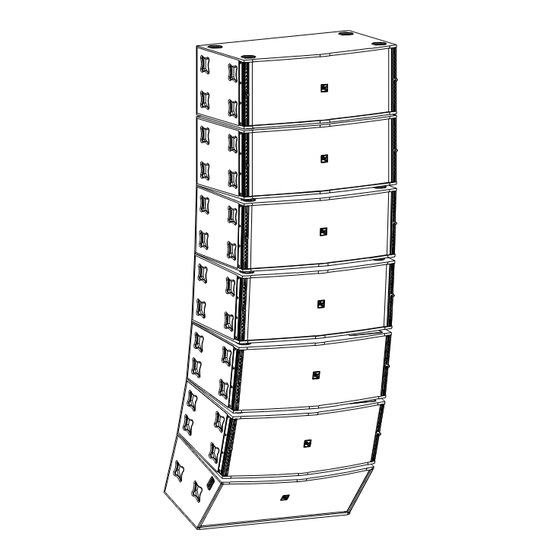
Table of Contents
Advertisement
Advertisement
Table of Contents

Summarization of Contents
1. X-Line Rigging System
1.1 Overview of the X-Line Flying System
Describes the X-Line system's design for acoustic line arrays, hinged rigging, and track hardware for easy, predictable assembly.
1.2 Enclosure Rigging Hardware Details
Details proprietary high-strength aluminum-alloy track and bracket assemblies used for front and rear rigging on X-Line enclosures.
1.3 Rear Rigging Hinge Details
Explains the Xvhg grid hinge and Xvhl linking hinge, their installation, and safety checks for rear rigging connections.
1.4 Front Rigging Strap Details
Covers Xvsg, Xvsl, and Xvsd chain rigging straps, their triple-stud fittings, and installation procedures for front rigging.
1.5 Xvbp Pull-Up Bar Details
Details the Xvbp pull-up bar used at the bottom of an array to adjust vertical splay angles when gravity is insufficient.
1.6 ATM X-Line Grid Details
Describes the ATM Flyware X-Line Grid, its rigging track compatibility, and attachment of top enclosures using Xvsg straps.
1.7 RS-1B Double-Stud Rigging Fitting
Introduces the RS-1B double-stud fitting for special lightweight applications and pull-up assemblies.
2. X-Line Rigging and Flying Techniques
2.1 Array Considerations
Discusses constructing acoustic line arrays with X-Line systems, stereo configurations, and mirror imaging for optimal coverage.
2.2 Adjusting the Vertical Angles of the Enclosures
Explains how to adjust enclosure vertical angles using front rigging strap attachment locations and chain lengths.
2.3 Deciding Whether to Use an Xvhg or Xvhl at the Grid
Compares Xvhg grid hinges and Xvhl linking hinges for rear attachment to the grid, considering flexibility and rigidity.
2.4 Rigging an Array with Boxes Using X-Line Dollies
Details techniques for rigging arrays using Bottom Stacking Dollies, Downfill Stacking Dollies, and Front Dollies.
2.5 Pull-Up Techniques
Describes using pull-up assemblies like the Xvbp bar for achieving necessary cabinet angles when gravity is insufficient.
3. Rigging-Strength Ratings, Safety Factors, and Special Safety Considerations
3.1 Working-Load Limit and Safety Factor Definitions
Defines working-load limit (WLL) and safety factors, emphasizing a 5:1 ratio and user responsibility for compliance.
3.2 Structural Rating Overview
Outlines the two independent strength ratings: individual rigging point strength and overall enclosure strength.
3.3 Simplified Structural-Rating Guidelines
Presents simplified guidelines for evaluating array safety based on angles, weight, and rigging hardware configurations.
3.4 Complex Structural-Rating Analysis
Explains the need for detailed analysis of forces on rigging hardware and enclosures, recommending consultation with structural engineers.
3.5 Wind Loading
Addresses the system's design to survive winds up to 60 mph and advises against overhead suspension in high winds.
3.6 Electro-Voice Structural-Analysis Procedures
Describes Electro-Voice's structural testing and computer-modeling procedures used in product development and verification.
4. Rigging Inspection and Precautions
Electro-Voice X-Line Loudspeaker Systems
Inspect enclosures for cracks, deformations, or missing components that could reduce strength before each use.
Electro-Voice X-Line Rear Rigging Hinges
Check rear rigging hinges for cracks, corrosion, or damage; ensure they are securely locked before lifting.
Electro-Voice X-Line Front Chain Rigging-Strap Assemblies
Inspect front rigging straps for chain or fitting damage; verify secure locking of fittings before lifting.
Electro-Voice X-Line Pull-Up Bars
Inspect pull-up bar assembly for damage and ensure all rigging hinges are securely locked prior to lifting.
Grid Assemblies
Inspect grid assemblies and associated hardware for damage or deformation, and verify load limitations.
Chain Hoists
Inspect chain hoists for damage and follow manufacturer recommendations for operation and certification.
Building, Tower or Scaffold Supports
Evaluate structural supports for adequacy and certify them with a professional engineer before use.
Miscellaneous Mechanical Components
Inspect mechanical components like chains, slings, shackles for damage or wear, and adhere to manufacturer limits.













Need help?
Do you have a question about the Xsub and is the answer not in the manual?
Questions and answers